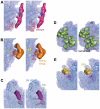Structural diversity in bacterial ribosomes: mycobacterial 70S ribosome structure reveals novel features
- PMID: 22384065
- PMCID: PMC3286452
- DOI: 10.1371/journal.pone.0031742
Structural diversity in bacterial ribosomes: mycobacterial 70S ribosome structure reveals novel features
Abstract
Here we present analysis of a 3D cryo-EM map of the 70S ribosome from Mycobacterium smegmatis, a saprophytic cousin of the etiological agent of tuberculosis in humans, Mycobacterium tuberculosis. In comparison with the 3D structures of other prokaryotic ribosomes, the density map of the M. smegmatis 70S ribosome reveals unique structural features and their relative orientations in the ribosome. Dramatic changes in the periphery due to additional rRNA segments and extra domains of some of the peripheral ribosomal proteins like S3, S5, S16, L17, L25, are evident. One of the most notable features appears in the large subunit near L1 stalk as a long helical structure next to helix 54 of the 23S rRNA. The sharp upper end of this structure is located in the vicinity of the mRNA exit channel. Although the M. smegmatis 70S ribosome possesses conserved core structure of bacterial ribosome, the new structural features, unveiled in this study, demonstrates diversity in the 3D architecture of bacterial ribosomes. We postulate that the prominent helical structure related to the 23S rRNA actively participates in the mechanisms of translation in mycobacteria.
Conflict of interest statement
Figures






Similar articles
-
The Complete Structure of the Mycobacterium smegmatis 70S Ribosome.Cell Rep. 2017 Jul 5;20(1):149-160. doi: 10.1016/j.celrep.2017.06.029. Cell Rep. 2017. PMID: 28683309
-
Structural insights into species-specific features of the ribosome from the human pathogen Mycobacterium tuberculosis.Nucleic Acids Res. 2017 Oct 13;45(18):10884-10894. doi: 10.1093/nar/gkx785. Nucleic Acids Res. 2017. PMID: 28977617 Free PMC article.
-
Structures of Mycobacterium smegmatis 70S ribosomes in complex with HPF, tmRNA, and P-tRNA.Sci Rep. 2018 Sep 11;8(1):13587. doi: 10.1038/s41598-018-31850-3. Sci Rep. 2018. PMID: 30206241 Free PMC article.
-
Unique structural features of the Mycobacterium ribosome.Prog Biophys Mol Biol. 2020 May;152:15-24. doi: 10.1016/j.pbiomolbio.2019.12.001. Epub 2019 Dec 10. Prog Biophys Mol Biol. 2020. PMID: 31858996 Review.
-
The ribosome through the looking glass.Angew Chem Int Ed Engl. 2003 Aug 4;42(30):3464-86. doi: 10.1002/anie.200200544. Angew Chem Int Ed Engl. 2003. PMID: 12900959 Review.
Cited by
-
Reconstitution of Protein Translation of Mycobacterium Reveals Functional Conservation and Divergence with the Gram-Negative Bacterium Escherichia coli.PLoS One. 2016 Aug 26;11(8):e0162020. doi: 10.1371/journal.pone.0162020. eCollection 2016. PLoS One. 2016. PMID: 27564552 Free PMC article.
-
Bacterial ribosome heterogeneity facilitates rapid response to stress.J Bacteriol. 2025 Jun 24;207(6):e0005825. doi: 10.1128/jb.00058-25. Epub 2025 Jun 3. J Bacteriol. 2025. PMID: 40459299 Free PMC article. Review.
-
Cryo-EM structure of Mycobacterium smegmatis ribosome reveals two unidentified ribosomal proteins close to the functional centers.Protein Cell. 2018 Apr;9(4):384-388. doi: 10.1007/s13238-017-0456-9. Protein Cell. 2018. PMID: 28875450 Free PMC article. No abstract available.
-
Leaderless Transcripts and Small Proteins Are Common Features of the Mycobacterial Translational Landscape.PLoS Genet. 2015 Nov 4;11(11):e1005641. doi: 10.1371/journal.pgen.1005641. eCollection 2015 Nov. PLoS Genet. 2015. PMID: 26536359 Free PMC article.
-
PdtaS Deficiency Affects Resistance of Mycobacteria to Ribosome Targeting Antibiotics.Front Microbiol. 2017 Nov 3;8:2145. doi: 10.3389/fmicb.2017.02145. eCollection 2017. Front Microbiol. 2017. PMID: 29163430 Free PMC article.
References
-
- Schmeing TM, Ramakrishnan V. What recent ribosome structures have revealed about the mechanism of translation. Nature. 2009;461:1234–1242. - PubMed
-
- Baker R, Ridell M, Lind A, Ouchterlony O. Immunodiffusion studies of various structural preparations from mycobacterial cells. Int Arch Allergy Appl Immunol. 1979;59:328–336. - PubMed
-
- Lonnroth I, Ridell M. Analyses of ribosomal proteins from mycobacteria with particular reference to the beta antigen. FEMS Microbiology Letters. 1985;27:203–207.
Publication types
MeSH terms
Substances
LinkOut - more resources
Full Text Sources

